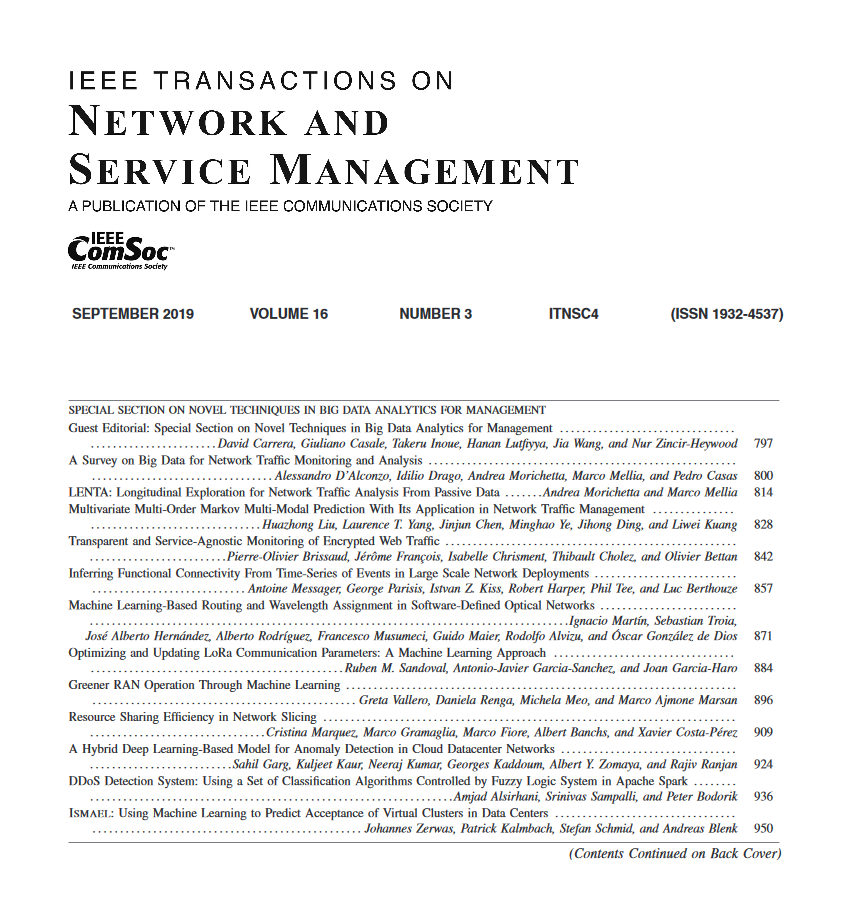主干网黑洞预测:一种综合、类型无关的预测模型
IF 5.4
2区 计算机科学
Q1 COMPUTER SCIENCE, INFORMATION SYSTEMS
IEEE Transactions on Network and Service Management
Pub Date : 2025-06-20
DOI:10.1109/TNSM.2025.3581557
引用次数: 0
摘要
网络骨干黑洞(BH)造成网络中断和数据丢失,路由器在没有通知的情况下静默地丢弃数据包,给互联网带来了重大挑战。这些沉默的BH故障源于硬件故障或配置错误等问题,只会影响点对点的数据包流,而不会中断整个网络。与网络攻击和网络入侵不同,黑洞通常无法追踪,因此早期发现至关重要且具有挑战性。该研究解决了对黑洞发生的有效预测解决方案的需求,特别是在传统异常检测方法不足的未标记交通数据环境中。引入了类型无关的黑洞预测模型,以高精度预测各种异常的黑洞发生,包括背景异常和集体异常类型。三阶段方法处理未标记的时间序列网络数据,其中数据未预先标记为异常或正常,使用机器学习和深度学习技术来识别和预测潜在的黑洞发生。“点BH识别和分离”阶段使用基于密度的空间聚类应用与噪声(DBSCAN)分离点BH流量,然后是重新整合和时间序列平滑。最后一个阶段,高级上下文和集体黑洞检测,利用带有窗口滑动的卷积自动编码器(conve - ae)进行高级异常检测。使用双数据集方法(包括真实骨干网流量和时间序列自适应公共数据集)进行评估,证明了该模型对真实骨干网BH检测系统的适应性。实验结果表明,与目前最先进的无监督异常预测模型相比,该模型的检测率为98%,F-1得分为90%,优于MultiHeadSelfAttention等模型,而MultiHeadSelfAttention是transformer的主要组成部分。本文章由计算机程序翻译,如有差异,请以英文原文为准。
Black Hole Prediction in Backbone Networks: A Comprehensive and Type-Independent Forecasting Model
Network backbone black holes(BH) pose significant challenges in the Internet by causing disruptions and data loss as routers silently drop packets without notification. These silent BH failures, stemming from issues like hardware malfunctions or misconfigurations, uniquely affect point-to-point packet flows without disrupting the entire network. Unlike cyber attacks and network intrusions, BHs are often untraceable, making early detection vital and challenging. This study addresses the need for an effective forecasting solution for BH occurrences, especially in environments with unlabeled traffic data where traditional anomaly detection methods fall short. The Type-Independent Black Hole Forecasting Model is introduced to predict BH occurrences with high precision across various anomalies, including contextual and collective anomaly types. The three-stage methodology processes unlabeled time-series network data, where the data is not pre-labeled as anomaly or normal, using machine learning and deep learning techniques to identify and forecast potential BH occurrences. The ‘Point BH Identification and Segregation’ stage segregates point BH traffic using Density-Based Spatial Clustering of Applications with Noise(DBSCAN), followed by Reintegration and Time Series Smoothing. The final stage, Advanced Contextual and Collective BH Detection, leverages Convolutional AutoEncoder(Conv-AE) with window sliding for advanced anomaly detection. Evaluation using a dual-dataset approach, including real backbone network traffic and a time-series adapted public dataset, demonstrates the adaptability of the model to real backbone BH detection systems. Experimental results show superior performance compared to state-of-the-art unsupervised anomaly forecasting models, with a 98% detection rate and 90% F-1 score, outperforming models like MultiHeadSelfAttention, which is the main building block of Transformers.
求助全文
通过发布文献求助,成功后即可免费获取论文全文。
去求助
来源期刊

IEEE Transactions on Network and Service Management
Computer Science-Computer Networks and Communications
CiteScore
9.30
自引率
15.10%
发文量
325
期刊介绍:
IEEE Transactions on Network and Service Management will publish (online only) peerreviewed archival quality papers that advance the state-of-the-art and practical applications of network and service management. Theoretical research contributions (presenting new concepts and techniques) and applied contributions (reporting on experiences and experiments with actual systems) will be encouraged. These transactions will focus on the key technical issues related to: Management Models, Architectures and Frameworks; Service Provisioning, Reliability and Quality Assurance; Management Functions; Enabling Technologies; Information and Communication Models; Policies; Applications and Case Studies; Emerging Technologies and Standards.
 求助内容:
求助内容: 应助结果提醒方式:
应助结果提醒方式:


